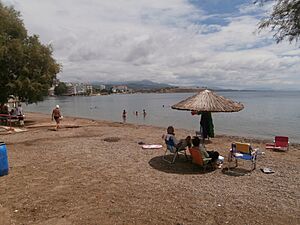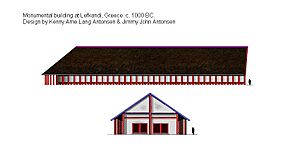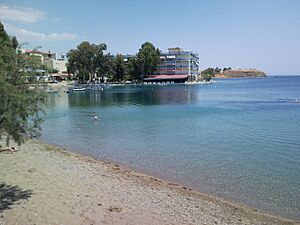Lefkandi facts for kids
Lefkandi is an ancient village located on the island of Euboea in Greece. Archaeologists have found evidence of a settlement on a piece of land called Xeropolis. Many old burial grounds, or cemeteries, have also been found nearby. This ancient site sits on a headland overlooking the Euripos Strait, with natural harbors on either side.
The cemeteries are located on the hillsides to the northwest of the settlement. Some of the known burial areas include the East Cemetery, Skoubris, Palia Perivolia, and Toumba. Lefkandi is situated between two important ancient cities, Chalkis and Eretria. The British School at Athens has been leading the archaeological digs here for many years.
People lived in Lefkandi for a very long time, starting in the Early Bronze Age. They continued to live there through the Bronze and Iron Ages, until the early 7th century BCE. The cemeteries mostly date to a period known as the "Greek Dark Ages" (around 1050–800 BCE). When people stopped living in Lefkandi, the nearby city of Eretria started to grow. Some archaeologists believe that Lefkandi might actually be the original site of Old Eretria.
Why Lefkandi is Important
Lefkandi is a very important archaeological site for several reasons. First, archaeologists found many layers of buildings and artifacts from the Late Helladic IIIC period (around 1200–1075 BCE). These finds helped experts understand what life was like during a time when not much was known about ancient Greece.
Unlike many other places in Greece, like the Peloponnese, Lefkandi continued to be an active settlement after the end of the Mycenaean palace period. This makes Lefkandi special, as it shows continuous life during a challenging time. Also, items found in the cemeteries show that people in Lefkandi traded with places like Cyprus and the Levant (the eastern Mediterranean).
The Hero's Grave Discovery
In 1980, archaeologists made an amazing discovery at Lefkandi. They found a large mound that contained two special graves. One grave held the remains of a man and a woman. This grave was underneath a very large building that some experts call a hērōön, which means "hero's grave." The other grave contained four horses, which seemed to have been sacrificed and buried with the people. Two of the horses even had iron bits still in their mouths.
There is some debate about whether this building was truly a hērōön built for a hero. Some think it was just the grave of an important couple.
Archaeologists have different ideas about how this large building was constructed around 950 BCE. One idea suggests it was about 50 meters (164 feet) long and 13.8 meters (45 feet) wide. This design included a wooden porch, which was very advanced for its time and looked similar to later Greek temples. A newer idea suggests the building was not as tall, and the "porch" might have been more like a fence around the house.
One of the bodies in the grave was cremated, meaning it was burned. The ashes were wrapped in a special cloth and placed inside a bronze jar from Cyprus. This jar had a hunting scene carved on it and was placed inside an even larger bronze bowl. A sword and other valuable items were found nearby. It is believed these were the ashes of a man.
The woman's body was not cremated. She was buried next to a wall and wore beautiful jewelry. This included a ring made of electrum (a mix of gold and silver), a bronze chest plate, and a necklace that might have come from Babylonia. This necklace was already very old, perhaps a thousand years old, when it was buried! An iron knife with an ivory handle was found near her shoulder.
It's not clear if the woman was buried at the same time as the man, or later. Some scholars have wondered if the woman was killed to be buried with the man, perhaps her husband. However, other experts say there is no clear proof she was sacrificed. They suggest she might have been an important person in her own right, who was buried with the man's ashes after her own death.
Xeropolis Settlement
Archaeological digs at Lefkandi have shown that people lived continuously on the Xeropolis headland from the Mycenaean period, through the Dark Ages, and into historical times. Some archaeologists believe that this site could be the ancient city of Old Eretria. They think that the people of Old Eretria might have been forced to move further away from Chalkis because of a conflict called the Lelantine War.





